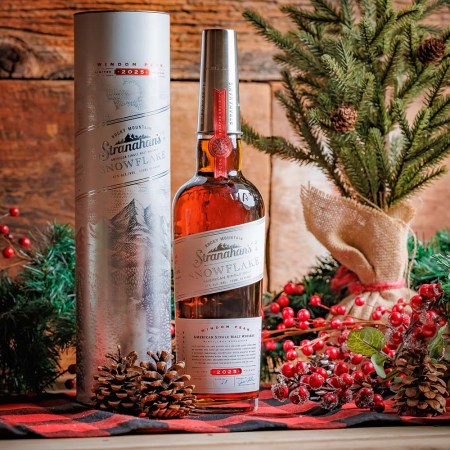“We’re here to make single malts for the American palate.” That’s a fairly big goal for Phil Steger, the brains behind Brother Justus, a whiskey distillery in Minneapolis that utilizes all local ingredients, right down to the peat. Getting our fellow countrymen to embrace an American Single Malt has already been a challenge, and offering whiskeys that have been aged barely a year doesn’t sound like a recipe for mainstream success.
Steger didn’t start with any distilling experience, but he saw that as an advantage. “How do you go about becoming great at something?” he asks. “I think you have to be a beginner at it. Go to the fundamentals, don’t be afraid of work. I didn’t have a bourbon or a Scotch background, that might be an advantage if I wanted to do something new. And if I didn’t have something new to say in whiskey, why would anyone care?”
Taking well over a decade to launch — thanks to some archaic Minnesota distilling laws that are thankfully now tweaked to help smaller producers — and starting from just a 26-gallon still in a basement, today Brother Justus is an award-winning whiskey (including a Double Gold from the San Francisco World Spirits Competition) with multiple releases available nationwide. Their single malts do a superb job of balancing sweet and savory; their latest Founder’s Reserve is close to an Old Fashioned in a bottle, while their Silver (new make) is almost tropical. And, of course, they have a proprietary peated release.

But those are just the headlines. Dive deep and you’ll find out why Brother Justus is different from almost any American whiskey brand.
It’s Named After a Rebellious Monk From Minnesota
Brother Justus is a real person. He was a monk in central Minnesota who used a monastery to help farmers illegally make moonshine during Prohibition. He made stills and taught people how to distill so they could provide for their families during a difficult time.
And while Steger had no distilling background, he did have a history working with monks. “They’re the inventors of whiskey,” he says (it’s true). “And for about 600 years, they were the only people who made it.”
The Founder’s Backstory Is the Opposite of Every American Whiskey Story Ever
“I was preserving ancient manuscripts in the Middle East,” Steger says, who earned his law degree from the University of St. Thomas and his bachelor’s degree in theology from St. John’s University (and as an attorney, he helped companies decarbonize energy supplies and represented asylum seekers from Syria and Iraq). “Then, on a vacation, I took a tour through a Kentucky distillery and realized almost none of their ingredients, except the water, was from Kentucky. I could make a whiskey from all Minnesota-sourced ingredients. That idea hit me in, literally, a flash. In that moment, it was like, ‘oh, this is going to be my manuscript.’” And instead of corn and rye, Steger turned to barley and (seriously) local peat, as you’ll see below.
Keeper’s Heart Marks the Debut of a New Style of Whiskey
The first release from the Minnesota-based O’Shaugnessy Distilling Co. showcases the best of American and Irish whiskeys, all for just $30They’ve Created Their Own Peated Whiskey Process
Nobody has a whiskey like this, particularly a peated whiskey. Brother Justus utilizes a process called “Cold-Peated,” which is sort of like a twist on Tennessee’s famous Lincoln County Process that involves filtering whiskey through charcoal. Here it’s known as the Aitkin County Process, where the whiskey is filtered through peat from a nearby county (the process is much more eco-friendly than peat smoking). “Minnesota has seven million acres of peat bog,” Steger says. “It has as much peat as Scotland and Ireland combined.” The result is a very subtle, earthy flavor that has a lot of chocolate and umami notes.
Their Whiskey Aging Is Incredibly Minimal
We’re talking a year or two at most for the Brother Justus releases. “Age does make a difference,” Steger says. “But I think a lot of our aging conventions in the United States are based around corn and rye as foundational ingredients. Those grains have limited chemistry. And great whiskey is a result of great whiskey chemistry.” Steger credits not only his barley-focused mash bill but the quality of his new make and the use of Minnesota-grown white oak for the barrels.
Brother Justus’s Young Whiskey Reads Like an Ancient Manuscript
Remember how Steger was studying old manuscripts? He sees a connection between his past work and his present distilling. “Look at whiskey — it’s a manuscript,” he says. “With manuscripts, you’re taking very simple raw materials, like animal skins, crushed plants and crushed rocks, and you’re creating these incredible works of art that endure the ages and contain identity and story and history and land. With whiskey, you’re taking very simple material — grain, a piece of wood, water, yeast, some turf out of the ground — and you’re creating this incredible explosion of flavor. In manuscripts, when you open up a page and there’s a gold-leafed page, you call that an illumination. That to me is what whiskey is. Whiskey is always an illumination. It has a brightness and a light and the inside is bigger than the outside.”
Every Thursday, our resident experts see to it that you’re up to date on the latest from the world of drinks. Trend reports, bottle reviews, cocktail recipes and more. Sign up for THE SPILL now.


























